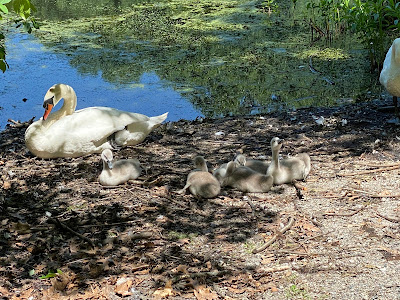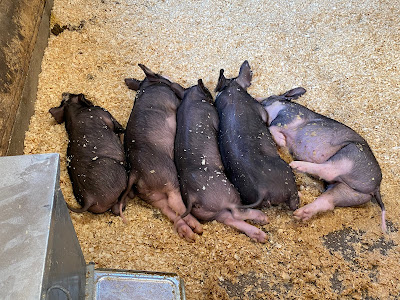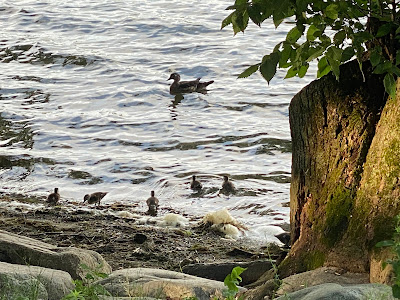June 2024 Bird book submitted to MIT Press!!
My big news is that I submitted my bird book, Birds Up Close: An Engineer Explores their Hidden Wonders, to MIT Press this week. Very exciting!!
Saturday June 1 The original 7 cygnets at Ward's Pond are now down to 5. Someone Susan ran into at the pond said that she saw one go under and not come up. The word on the footpath is that snapping turtles are pulling them under.
Wednesday June 5 Boston has had a cloud of pollen hanging over the city the last couple of days. In the news outlets' photos you can see the huge yellowish-green cloud hanging below the blue sky. The pollen was just everywhere - covering cars, in streaks around catch basins, up my nose. Susan took this photo on a walk along the Charles River. You get the idea. Yikes.
 |
| Susan Brand |
Monday June 10 I went to National Audubon's Hog Island bird camp off the coast of Maine, near Damariscotta, to give my feather talk. Two bird groups there this week: one adults and one teenagers (13-17). After my talk, some of the teenagers came up to chat - some said something along the line of 'we take science in school, but never realized you could use it like this, for understanding birds'. Others wanted to talk with me about my project on desert sandgrouse, birds that carry water from watering holes in their belly feathers back to their chicks in the desert (who can't fly). They were fascinated by the scanning electron microscope and micro-computed tomography images I showed them of dry and wet feathers, and how the feathers work. They were so engrossed that one of the people who runs the camp told them it was time to go to bed (so that they could get up for the 5:30 am bird walk the next morning).
Project Puffin, which sets out decoys to encourage puffins to land and nest on a nearby island, is based at Hog Island. Here are some of their other decoys, of terns, a black skimmer (second from left), some sort of auklet (with the funky crest) and a gull.
And the view from the island...
Saturday June 15 In Provincetown with Susan, walking along Commercial Street, admiring the beautiful gardens.
Monday June 17 This evening as it was getting dark, I was sitting in my sunroom, chatting with Nicole, the Arb intern who is staying at my house this summer, when she said "There's an opossum out there!" And when I turned around, there it was, on the fence. It walked along the fence and disappeared down the far end.
A couple of days later, Nicole told me she saw one again in the evening, scampering upside down along the telephone wire at the back of my yard. Wish I'd seen that!Tuesday June 18 After an Audubon meeting at Drumlin Farm, one of their sanctuaries, we went to the pig barn to check out the piglets, now a couple of months old. Cute, but when they get to 120 pounds, they go to market.
Had to check on the goat kids, too - they're getting bigger and more used to people. This one looks particularly blissful, getting its chin scratched.
Thursday June 20 When I walk along my street on the way to and from my early morning walks around Jamaica Pond these days, the street is full of birdsong. Most years I see young robins, sparrows, and blue jays, either on the ground or flying a bit haphazardly. This morning, I spotted a juvenile downy woodpecker, its feathers a bit askew, not entirely in adult plumage. Then a second, adult downy flew in, to check on how it was doing. The young one flew from tree to tree, followed by the adult for a few minutes as I watched.
The clouds and light at Jamaica Pond were gorgeous this evening.
Friday June 21 Down to only 2 cygnets at Ward's Pond. Argh. But perhaps these will make it to adulthood. They're getting pretty big for a turtle to get.
Sunday June 23 The blueberry bushes in my back garden. I suspect the birds will get them before I do.
I got an email from the Arboretum around 2:30 saying that their corpse plant was flowering, for the first time in the 11 years they've had it. Members were invited to come see it. I'd read about them before and was curious to see one in action. So I dropped everything and went over. Here's Ned Friedman, the Director of the Arb, excitedly showing it off.
And why are we all excited?
First, there's the Latin name: Amorphophallus titanum: "amorphos" = misshapen; "phallos" = phallic-shaped; "titanum" = giant. You get the picture.
Then there's the smell: the corpse plant emits the smell of rotting flesh to attract insects for pollination. Here's what the handout from the Arb says about the chemicals it produces: "Trimethylamine is responsible for the rank odor of rotting fish and marine animals, while isovaleric acid is best described as smelling like sweaty gym socks." There was a faint smell when I visited, but not as stinky as I thought it would be.
Apparently, the smell gets more intense at night. Ned was planning on returning at 1am.
Flowering corpse plants are rare: most plants flower only once every 5-10 years or so.
Then there are the botanical details: the large, purple phallic-like spear, the spathe, is surrounded by the green and red tube-shaped structure, the spadix, that look like giant petals (but are not). Inside the spadix are hundreds of tiny flowers, with both female flowers (at the base) and male flowers, producing pollen, higher up. The female flowers are mature and ready for pollination on only one night, but the male flowers don't produce pollen until the following night, so that the plant doesn't pollinate itself. This means that the flower lasts for only 24-48 hours! Then it's over - it withers and morphs into its leaf cycle, waiting for years to flower again.
And there's another twist to its story: during flowering, the plant generates heat, making the stinky chemicals vaporize more readily, intensifying the smell. The skunk cabbage that you see in marshy areas in eastern North America uses the same trick in late winter/early spring to melt the snow surrounding the new shoots.
Monday June 24 Wood ducklings at the pond this morning - a mom with 7 ducklings, very cute.
The Arb intern who stayed at my house last summer, Tanner, and his girlfriend, Rachel, are in Boston this week for the American Public Garden Association conference. We had arranged to meet up for dinner tonight. But first, we had to go over to the Arb to see the corpse flower. Here are Tanner and Rachel with it.
This afternoon, I met with my editor at MIT Press to go over the last, minor formatting details to take care of before submitting the book. We also talked about the production schedule - sending it out for peer review, copy editing, design and layout, checking galley proofs, indexing and, finally, printing. The Press is hoping to have it in print in the fall of 2025.
Wednesday June 26 Sent the book to MIT Press! Very exciting!! The last 6 months have been very busy, between revising the text into the final form and getting all 150+ figures ready. Many thanks to Toby Lester, the editor who helped with the text, my friend, Beth Beighlie, who put the figures into Adobe Illustrator, and to Erica Beade, who did some beautiful drawings of birds for the book.
Having finished the book, I can now relax in Ptown. The beach outside Susan's condo at low tide.
Thursday June 27 Susan and our friend, Beth, who is visiting, threw a surprise book party for me this evening. Drinks on the balcony, party streamers, salade Nicoise, and a fancy party hat for me. I was very touched.
Friday June 28 Walking at the Beech Forest we spotted these ghost pipes, aka Indian pipes (but did not pick them). Despite their appearance, they are not fungi.
Saturday June 29 Went for a walk at the Truro High Head conservation area, just outside of Provincetown this afternoon. Blueberries ripening along the side of the path.
And a "wolf tree".
 |
| Black oak wolf tree |
The sign next to the tree explained:
"Europeans called ancient trees that persist in a landscape which has dramatically changed during a tree's lifespan 'legacy trees'. Scattered throughout New England are some special legacy trees called 'wolf trees'... When settlers from Europe arrived in North America, many of the forests were cut down to provide lumber for building as well as to clear fields for planting....The name is thought to come from these old, massive trees, devouring too much space and sunlight, similar to the wolves that were being hunted down for consuming too many resources."
Happy Canada Day tomorrow!



















.svg.png)



Comments
Post a Comment